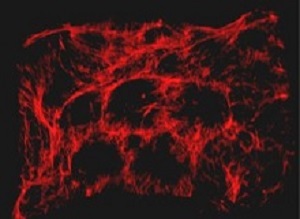
Researchers at the University of New Hampshire have created an easy-to-make, low-cost injectable hydrogel that could help wounds heal faster, especially for patients with compromised health issues.
Wound healing can be complex and challenging, especially when a patient has other health obstacles that seriously impede the process. Often injectable hydrogels are applied to irregular shaped wounds, like diabetic ulcers, to help form a temporary matrix, or structure, to keep the wound stable while cells rejuvenate. The caveat is that current hydrogels are not porous enough and do not allow neighbouring cells to pass through toward the wound to help it mend.
"While valuable for helping patients, current hydrogels have limited clinical efficacy," said Kyung Jae Jeong, assistant professor of chemical engineering at UNH. "We discovered a simple solution to make the hydrogels more porous and therefore help to speed up the healing."
In the study, the researchers outline how they made a macro-porous hydrogel by combining readily available gelatin microgels – hydrogels that are a few hundred microns in diametre – with an inexpensive enzyme called microbial transglutaminase (mTG).
Gelatin was used because it is a natural protein derived from collagen, a protein found in connective tissue in the body such as skin. Assembling these tiny microgels with mTG helped create a hydrogel with large enough pores for the neighbouring cells to move into the wound for repair. In addition, this new injectable formulation allows for the slow release of protein drugs to aid wound healing, such as platelet-derived growth factor (PDGF). The researchers compared conventional nonporous hydrogels with the new macro-porous hydrogels, and found a notable increase in the migration of tissue cells inside the hydrogel, which is the hallmark of wound healing.
Along with diabetic ulcers, the macro-porous hydrogel could help with other forms of healing on the skin, cornea, internal organs during surgery and even has military implications.
Abstract
Injectable hydrogels can be useful tools for facilitating wound healing since they conform to the irregular shapes of wounds, serving as a temporary matrix during the healing process. However, the lack of inherent pore structures of most injectable hydrogels prohibits desired interactions with the cells of the surrounding tissues limiting their clinical efficacy. Here, we introduce a simple, cost-effective, and highly biofunctional injectable macroporous hydrogel made of gelatin microgels cross-linked by microbial transglutaminase (mTG). Pores are created by the interstitial space among the microgels. A water-in-oil emulsion technique was used to create gelatin microgels of an average size of 250 μm in diameter. When cross-linked with mTG, the microgels adhered to each other to form a bulk hydrogel with inherent pores large enough for cell migration. The viscoelastic properties of the porous hydrogel were similar to those of a nonporous gelatin hydrogel made by adding mTG to a homogeneous gelatin solution. The porous hydrogel supported a higher cellular proliferation of human dermal fibroblasts (hDFs) than the nonporous hydrogel over 2 weeks and allowed the migration of hDFs into the pores. Conversely, the hDFs were unable to permeate the surface of the nonporous hydrogel. To demonstrate its potential use in wound healing, the gelatin microgels were injected with mTG into a cut out section of an excised porcine cornea. Due to the action of mTG, the porous hydrogel stably adhered to the cornea tissue for 2 weeks. Confocal images showed that a large number of cells from the cornea tissue migrated into the interstitial space of the porous hydrogel. The porous hydrogel was also used for the controlled release of platelet-derived growth factor (PDGF), increasing the proliferation of hDFs compared to the nonporous hydrogel. This gelatin microgel-based porous hydrogel will be a useful tool for wound healing and tissue engineering.
Authors
Shujie Hou, Rachel Lake, Shiwha Park, Seth Edwards, Chante Jones, Kyung Jae Jeong
[link url="https://www.unh.edu/unhtoday/news/release/2018/11/20/unh-researchers-create-more-effective-hydrogel-healing-wounds"]University of New Hampshire material[/link]
[link url="https://pubs.acs.org/doi/10.1021/acsabm.8b00380"]ACS Applied Bio Materials abstract[/link]
